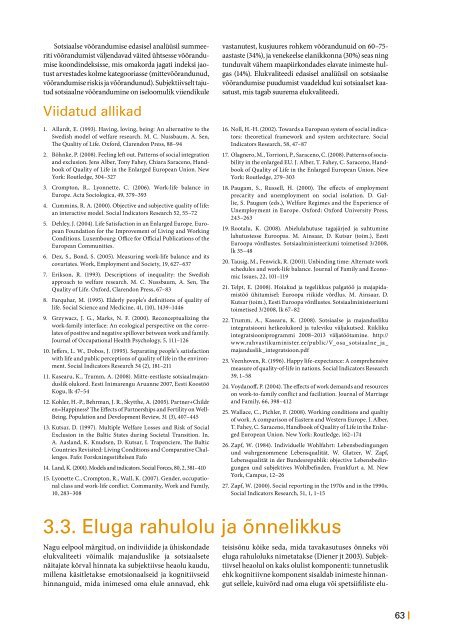Create successful ePaper yourself
Turn your PDF publications into a flip-book with our unique Google optimized e-Paper software.
Sotsiaalse võõrandumise edasisel analüüsil summeeriti<br />
võõrandumist väljendavad väited ühtsesse võõrandumise<br />
koondindeksisse, mis omakorda jagati indeksi jaotust<br />
arvestades kolme kategooriasse (mittevõõrandunud,<br />
võõrandumise riskis ja võõrandunud). Subjektiivselt tajutud<br />
sotsiaalne võõrandumine on iseloomulik viiendikule<br />
Viidatud allikad<br />
1. Allardt, E. (1993). Having, loving, being: An alternative to the<br />
Swedish model of welfare research. M. C. Nussbaum, A. Sen,<br />
The Quality of Life. Oxford, Clarendon Press, 88–94<br />
2. Böhnke, P. (2008). Feeling left out. Patterns of social integration<br />
and exclusion. Jens Alber, Tony Fahey, Chiara Saraceno, Handbook<br />
of Quality of Life in the Enlarged European Union. New<br />
York: Routledge, 304–327<br />
3. Crompton, R., Lyonnette, C. (2006). Work-life balance in<br />
Europe. Acta Sociologica, 49, 379–393<br />
4. Cummins, R. A. (2000). Objective and subjective quality of life:<br />
an interactive model. Social Indicators Research 52, 55–72<br />
5. Dehley, J. (2004). Life Satisfaction in an Enlarged Europe. European<br />
Foundation for the Improvement of Living and Working<br />
Conditions. Luxembourg: Office for Official Publications of the<br />
European Communities.<br />
6. Dex, S., Bond, S. (2005). Measuring work-life balance and its<br />
covariates. Work, Employment and Society, 19, 627–637<br />
7. Erikson, R. (1993). Descriptions of inequality: the Swedish<br />
approach to welfare research. M. C. Nussbaum, A. Sen, The<br />
Quality of Life. Oxford, Clarendon Press, 67–83<br />
8. Farquhar, M. (1995). Elderly people’s definitions of quality of<br />
life. Social Science and Medicine, 41, (10), 1439–1446<br />
9. Grzywacz, J. G., Marks, N. F. (2000). Reconceptualizing the<br />
work-family interface: An ecological perspective on the correlates<br />
of positive and negative spillover between work and family.<br />
Journal of Occupational Health Psychology, 5, 111–126<br />
10. Jeffers, L. W., Dobos, J. (1995). Separating people’s satisfaction<br />
with life and public perceptions of quality of life in the environment.<br />
Social Indicators Research 34 (2), 181–211<br />
11. Kasearu, K., Trumm, A. (2008). Mitte-eestlaste sotsiaalmajanduslik<br />
olukord. <strong>Eesti</strong> Inimarengu Aruanne 2007, <strong>Eesti</strong> <strong>Koostöö</strong><br />
<strong>Kogu</strong>, lk 47–54<br />
12. Kohler, H.-P., Behrman, J. R., Skytthe, A. (2005). Partner+Childr<br />
en=Happiness? The Effects of Partnerships and Fertility on Well-<br />
Being. Population and Development Review, 31 (3), 407–445<br />
13. Kutsar, D. (1997). Multiple Welfare Losses and Risk of Social<br />
Exclusion in the Baltic States during Societal Transition. In.<br />
A. Aasland, K. Knudsen, D. Kutsar, I. Trapenciere, The Baltic<br />
Countries Revisited: Living Conditions and Comparative Challenges.<br />
Fafo: Forskningsstiftelsen Fafo<br />
14. Land, K. (2001). Models and indicators. Social Forces, 80, 2, 381–410<br />
15. Lyonette C., Crompton, R., Wall, K. (2007). Gender, occupational<br />
class and work-life conflict. Community, Work and Family,<br />
10, 283–308<br />
vastanutest, kusjuures rohkem võõrandunuid on 60–75aastaste<br />
(34%), ja venekeelse elanikkonna (30%) seas ning<br />
tunduvalt vähem maapiirkondades elavate inimeste hulgas<br />
(14%). Elukvaliteedi edasisel analüüsil on sotsiaalse<br />
võõrandumise puudumist vaadeldud kui sotsiaalset kaasatust,<br />
mis tagab suurema elukvaliteedi.<br />
16. Noll, H.-H. (2002). Towards a European system of social indicators:<br />
theoretical framework and system architecture. Social<br />
Indicators Research, 58, 47–87<br />
17. Olagnero, M., Torrioni, P., Saraceno, C. (2008). Patterns of sociability<br />
in the enlarged EU. J. Alber, T. Fahey, C. Saraceno, Handbook<br />
of Quality of Life in the Enlarged European Union. New<br />
York: Routledge, 279–303<br />
18. Paugam, S., Russell, H. (2000). The effects of employment<br />
precarity and unemployment on social isolation. D. Gallie,<br />
S. Paugam (eds.), Welfare Regimes and the Experience of<br />
Unemployment in Europe. Oxford: Oxford University Press,<br />
243–263<br />
19. Rootalu, K. (2008). Abielulahutuse tagajärjed ja suhtumine<br />
lahutustesse Euroopas. M. Ainsaar, D. Kutsar (toim.), <strong>Eesti</strong><br />
Euroopa võrdlustes. Sotsiaalministeeriumi toimetised 3/2008,<br />
lk 35–48<br />
20. Tausig, M., Fenwick, R. (2001). Unbinding time: Alternate work<br />
schedules and work-life balance. Journal of Family and Economic<br />
Issues, 22, 101–119<br />
21. Telpt, E. (2008). Hoiakud ja tegelikkus palgatöö ja majapidamistöö<br />
ühitamisel: Euroopa riikide võrdlus. M. Ainsaar, D.<br />
Kutsar (toim.), <strong>Eesti</strong> Euroopa võrdlustes. Sotsiaalministeeriumi<br />
toimetised 3/2008, lk 67–82<br />
22. Trumm, A., Kasearu, K. (2008). Sotsiaalse ja majandusliku<br />
integratsiooni hetkeolukord ja tuleviku väljakutsed. Riikliku<br />
integratsiooniprogrammi 2008–2013 väljatöötamine. http://<br />
www.rahvastikuminister.ee/public/V_osa_sotsiaalne_ja_<br />
majanduslik_integratsioon.pdf<br />
23. Veenhoven, R. (1996). Happy life-expectance: A comprehensive<br />
measure of quality-of-life in nations. Social Indicators Research<br />
39, 1–58<br />
24. Voydanoff, P. (2004). The effects of work demands and resources<br />
on work-to-family conflict and faciliation. Journal of Marriage<br />
and Family, 66, 398–412<br />
25. Wallace, C., Pichler, F. (2008). Working conditions and qualtiy<br />
of work. A comparison of Eastern and Western Europe. J. Alber,<br />
T. Fahey, C. Saraceno, Handbook of Quality of Life in the Enlarged<br />
European Union. New York: Routledge, 162–174<br />
26. Zapf, W. (1984). Individuelle Wohlfahrt: Lebensbedingungen<br />
und wahrgenommene Lebensqualität. W. Glatzer, W. Zapf,<br />
Lebensqualität in der Bundesrepublik: objective Lebensbedingungen<br />
und subjektives Wohlbefinden, Frankfurt a. M. New<br />
York, Campus, 12–26<br />
27. Zapf, W. (2000). Social reporting in the 1970s and in the 1990s.<br />
Social Indicators Research, 51, 1, 1–15<br />
3.3. Eluga rahulolu ja õnnelikkus<br />
Nagu eelpool märgitud, on indiviidide ja ühiskondade<br />
elukvaliteeti võimalik majanduslike ja sotsiaalsete<br />
näitajate kõrval hinnata ka subjektiivse heaolu kaudu,<br />
millena käsitletakse emotsionaalseid ja kognitiivseid<br />
hinnanguid, mida inimesed oma elule annavad, ehk<br />
teisisõnu kõike seda, mida tavakasutuses õnneks või<br />
eluga rahuloluks nimetatakse (Diener jt 2003). Subjektiivsel<br />
heaolul on kaks olulist komponenti: tunnetuslik<br />
ehk kognitiivne komponent sisaldab inimeste hinnangut<br />
sellele, kuivõrd nad oma eluga või spetsiifiliste elu-<br />
63 |















